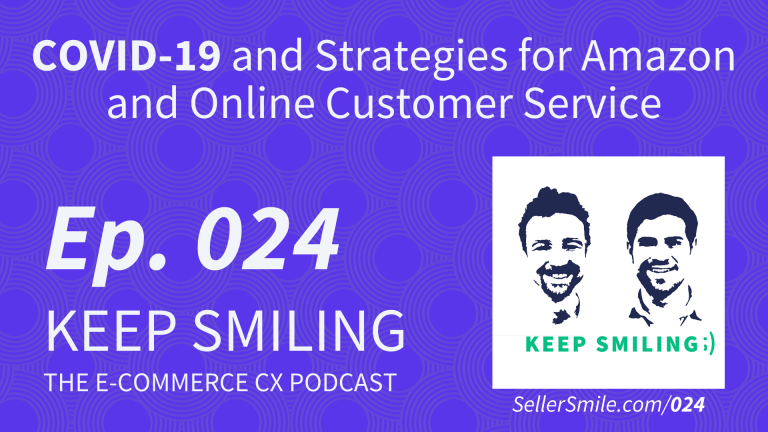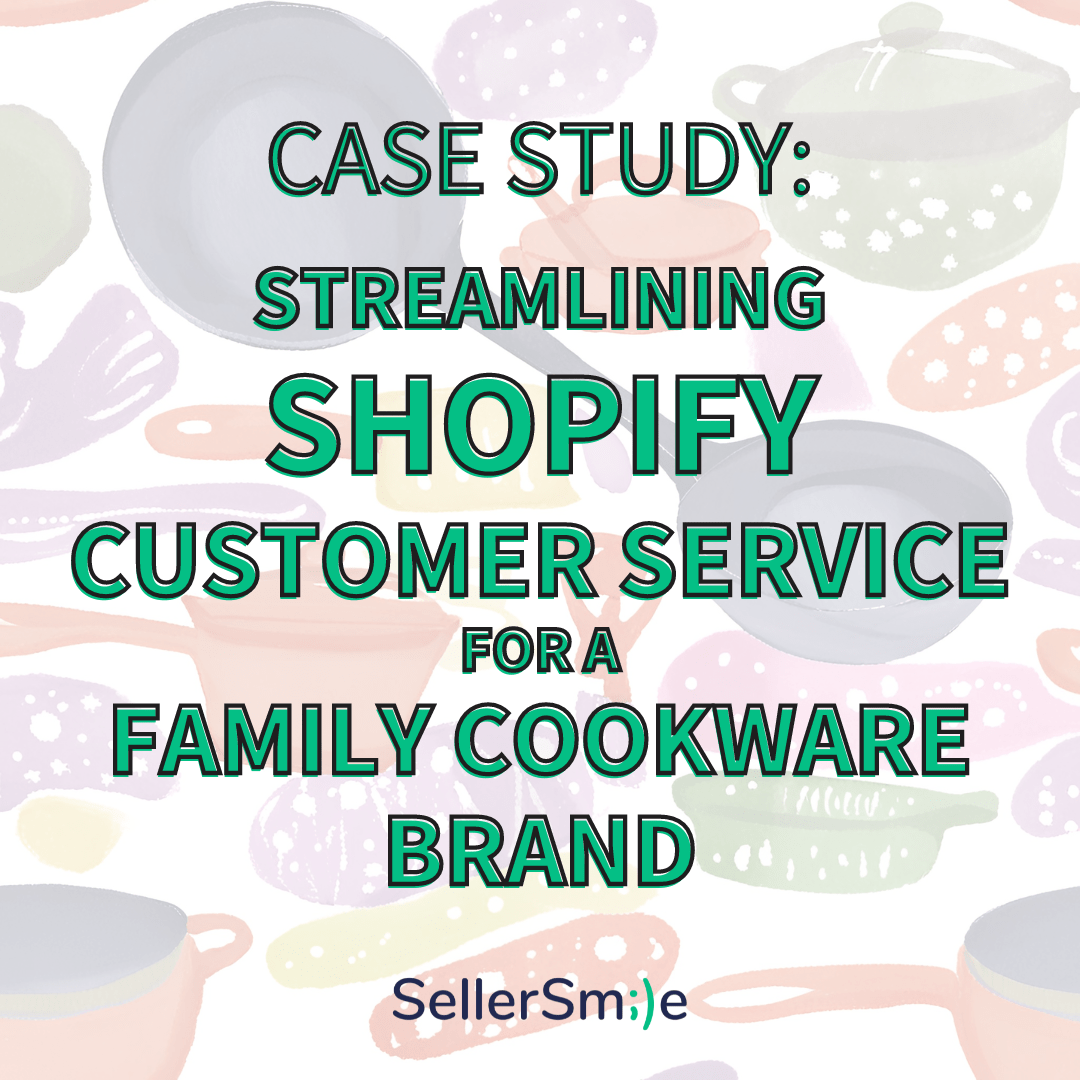Subscribe & review on iTunes | Stitcher | Google Play | Spotify.
(Updated 3/17/20)
We review how the recent COVID-19 outbreak and related changes are affecting our clients’ e-commerce businesses, plus, ways to prepare your support team to communicate supply chain disruptions to your customers.
Back from Hiatus
- Spent time on our agency business and holidays.
- New SellerSmile.com! Future episodes to discuss our customer service takeaways and advice.
1- COVID-19 Updates (as of March 17th, 2020)
“Coronavirus disease (COVID-19) outbreak. Coronaviruses (CoV) are a large family of viruses that cause illness ranging from the common cold to more severe diseases. Coronavirus disease (COVID-19) is a new strain that was discovered in 2019 and has not been previously identified in humans.”
Most authoritative sites to watch as of this time:
- Centers for Disease Control: cdc.gov.
- World Health Organization: https://www.who.int/.
How is COVID-19 Affecting Amazon sellers?
- Sales and customer service spike in some / ~dip in others.
- Certain categories related to the outbreak will be impacted differently.
- Increased cancellations and order change requests.
2- Amazon Announcements Related to Re-stocking and COVID-19
Amazon recently announced that they are, “Temporarily prioritizing products coming into our fulfillment centers”, which means some products can get in while others cannot.
“We are temporarily prioritizing household staples, medical supplies and other high-demand products coming into our fulfillment centers so that we can more quickly receive, restock, and ship these products to customers. For products other than these, we have temporarily disabled shipment creation. We are taking a similar approach with retail vendors.This will be in effect today through April 5, 2020, and we will let you know once we resume regular operations.“
- Amazon is no longer allowing sellers to sell certain things related to COVID-19, including:
“Disposable Face Masks, Hand Sanitizers, Hygienic Alcohol, Disinfecting Wipes/Spray: We have implemented more stringent requirements to sell products such as disposable face masks, hand sanitizers, disinfecting wipes/sprays, isopropyl alcohol, and related products. We are not accepting applications to sell these products at this time.“
3- Strategies for Internal Operations and Amazon Customer Service Related to Disruptions Due to COVID-19
- Stay up to date with Amazon Seller News.
- Shipment delays, issues?
- Adjust shipping templates for Amazon FBM listings.
- Adjust shipping estimates on your website FAQ.
- Make an announcement on your site, chatbots, and social media.
- Leverage FBM and other fulfillment options?
- Prepare COVID-19 canned responses. Explain order processing delays, out of stock, etc., are due to the general global supply chain disruption, rather than an issue with their particular order.
- Example template for delays: “Thank you for your message. Unfortunately, order processing and fulfillment are experiencing unprecedented delays due to COVID-19. [IF AMAZON include: Our fulfillment partner, Amazon, is prioritizing orders based on product type, and your order will be processed and shipped as soon as possible.] Thank you for your patience and understanding.”
- Amazon Order cancellations?
- Adjust FBM shipping templates to display updated, realistic shipping times.
- Your Amazon FBM Shipping settings: https://sellercentral.amazon.com/sbr/ref=xx_shipset_dnav_xx#shipping_templates
- Growing volume (Greater sales?)
- We’ve seen average messages per day go from ~10 per day to over 100 per day in one case.
- Plan for multiple times during the day to do your email check-ins, add more team members to your customer service team, create more/better templates, start or improve tagging/categorization, etc.
- Consult the SellerSmile Holiday Survival Guide.
- Out of stock log.
- Keep tabs so you can get back to customers as soon as the item/s are available.
- Offer a promo code toward a future purchase?
- Example response for out of stock:
- “Our sincere apologies for the inconvenience! We do not currently have an exact timeline on when this will be back in stock. We hope to have more available by ________. In the meantime, we’ll monitor this for you and reach out to you as soon as we’ve confirmed they are back in stock. Thank you for your patience and understanding.“
Since our entire team already works 100% remotely, we’re able to stay in our homes and continue our work despite the recent event suspensions and restrictions across our communities.
Health and safety are all of our responsibilities. Please stay informed to help slow the spread of COVID-19.
If you have questions about what we discussed today, or need customer service help, email us at keepsmiling@sellersmile.com.
Stay safe and keep smiling!!
Episode Transcript
[Tygh]: Hello listeners and thank you for joining us. I’m your host, Tygh Walters, and with me today is my co-host Michael Melgar. In today’s episode, we’ll be covering updates related to COVID-19. including your health, internal operations of your e-commerce business, as well as relevant Amazon announcements.
[Michael]: Hey everyone, thanks so much for joining us, you know, after a short hiatus for you, think our last episode came out in December, we’ve been very fortunate and thankful for the time we’ve had you know we’ve been able to dedicate our focus to launching a new and improved sellersmile.com. If you haven’t checked it out yet, go check it out. We’re actually gonna plan on recording a future episode where we’re gonna discuss some customer service takeaways, lessons learned, and ways that you can look at your website as a tool for your customer service. But, yeah, it allowed us some time to work on primarily this big project, for us, and focus on our agency business and the holiday coverage. You know, there’s holidays are very busy time for us but we’re gonna start recording regularly again and we wanted to jump right into it and cover the hot topic of the moment.
(1:31) [Tygh]: The topic today is COVID-19 and we’re recording today, on Tuesday, March 17th, 2020, and to start it off I just wanted to read a definition of what Coronavirus is. Coronaviruses are a large family of viruses that cause illness ranging from the common cold to more severe diseases coronavirus disease, or
CCOVID-19, is a new strain that was discovered in 2019 and has not been previously identified in humans.” For more information visit who.int. So, Michael and I would like to talk today about how this outbreak of COVID-19 is affecting ecommerce in general as well as how ecommerce sellers are doing their customer service in this crisis. To start it off, Michael though, let’s talk about some of the things that we can do as communities around the world to slow the global progress of this disease.
(2:29) [Michael]: First and foremost, we believe that you should prioritize your health and the health of those around you. Stay informed. We mentioned the World Health Organization website a moment ago, WHO.int, we also suggest still following along with CDC.gov. Protect yourself, protect those around you. If you have the ability to work remotely, please do so, but again, keep up with these two primary sources and your local government to see where things are at. All that being said, one of the biggest impacts come from some of the more recent Amazon announcements that we just heard about.
(3:02) [Tygh]: So recently, the SellerSmile team found an Amazon announcement which is featured in the dashboard inside a Seller Central account, which was announcing the temporary prioritization of products coming into fulfillment centers and what this means is that according to certain categories, Amazon is treating that inbound inventory (to restock your “shelves”) differently depending on the category. If the category pertains to the incident or this outbreak, it’s given preferential treatment to be expedited through the fulfillment process. If your product category lies outside of that of that list that Amazon is determined is relevant, you might see extended delays getting inventory back into FBA centers.
(03:47) [Michael]: and to be more specific there they’re actually stating that they’ve temporarily disabled shipment creation for those products that don’t match the categories their looking for, and that went into effect earlier this morning, I believe, when they made that announcement and it goes through, according to their announcement, it goes through April 5th of 2020, and they state in this announcement that they will let you know once the regular operations have resumed. So we strongly suggest keeping an eye on this, this will have an impact on shipments and so, like what your customers are able to get within what the certain time frames, so we’re gonna talk about a little bit more about this in a few moments but essentially, how that’s going to impact your customers expectations and, in turn, your sales, as well
(04:33) [Tygh]: the reason why Michael and I identified this announcement as being so relevant and important for this episode is because switching between being “in stock” and “out of stock” for a seller causes many customer service interactions and it’s one of the things that we try to avoid, just so our team is less bogged down and we can have more of the conversations and invest our resources in the conversations that matter more to us for improving our business. As long as the seller stays in stock we can limit those types of discussions from happening. But in this case, again, we’re likely to see those inquiries whether customers are shopping for something you used to offer or whether they may require a replacement of something they purchased from you previously. These conversations will definitely escalate if you are fluctuating between being out of stock and in stock, especially with a “best seller.”
(05:21) [Michael]: The second announcement that we heard from Amazon, as of a few days ago, was titled “Amazon no longer allowing sellers to sell certain things related to COVID-19.” So some of the items that they were mentioning here were face masks, hand sanitizers, hygienic alcohol, disinfectant wipes or sprays. It’s possible that Amazon could come back and release an update or perhaps even come back and clarify on some of these updates so definitely stay on top of these and try to, you know, come to your own conclusions on this.
(05:21) [Tygh]: If you’re a seller of these items and Amazon is requiring you to remove that inventory, they are offering a special reimbursement for the situations. There’s lots of updates happening with Amazon, the best place to receive the most accurate up-to-date news is inside of your Seller Central account. Amazon has a news feed directly at the top center, peruse those articles and that news feed for topics that are relevant to your business, especially as they pertain to getting stock back into Amazon. So, Michael,
we’ve talked about some of the health concerns and some of the sources of information we’ve talked about how a seller should stay in contact with Amazon so they can forecast how to treat their customer service. Let’s talk a little bit about what we’re doing as SellerSmile, how are we approaching this from our internal operations of literally scheduling with human beings and working with their schedules as they’re dealing with this outbreak nationwide and globally, because right now we’re in the process with all of our clients of understanding how is your business being affected and how can we, as your customer service team, help. What can we anticipate? What can we prepare for, and which response do we want to have moving forward?
(06:57) [Michael]: Certainly, I think the crux of this relies on the speed of the action. You might not be a hundred percent sold on this is the best action to take right away. You know, if you’re 75-85% you know, 80% sure that might you know that might you be your best bet. The reason why I state that is because all of this can change on a day-to-day basis with a lot of the news that we were receiving and the news that Amazon puts out. So again, use the information that you’re given to try to make your the best judgment call. It’s likely not going to be the perfect decision, either way, try to keep that in mind but, in general, you know, you’re gonna start seeing shipment delays, issues, right, so one of the things that we would suggest doing as the seller is adjusting your shipping template.
(07:41) [Tygh]: As an FBM seller, if you’re fulfilling your own products, Amazon requires you to design a shipping template and assign that to SKUs in your inventory. If we are seeing now, or in the future, extended delays with shipping, you might be able to send a proactive message about this to your prospective customers because they’re gonna see that on the listing, on the customer side of what is a more realistic time for delivery. Now, certainly you wouldn’t want to turn away business if you felt like you could fulfill those orders on time but ultimately we want to be as transparent with the customer about the experience that’s actually going to happen, and if that’s an extended shipping timeline, we recommend being upfront and transparent about that in your listing. So take a look at your current shipping templates and adjust any that may be affected by this.
(08:24) [Michael]: Absolutely, it might just be a matter of this information is now outdated because of some of the information that we know now. Right around, you know, right along the same lines, it might be just as helpful to make an announcement on your website or on your social media. If you use, like, chatbots on your website, for example, this is a great opportunity to say, “Hey, just as a heads-up, we have some delayed shipments due to COVID-19, we’re so sorry, here’s how we can help.” And that’s some of the information that you can provide right up front – just to be able to manage expectations right from the get-go.
(08:56) [Tygh]: And of course with automatic outbound messaging, if you’re using tools like that, including a quick message to let the customer know what to expect is always going to be advised. And finally, if you’re primarily a seller that relies on FBA and maybe you have a mixed model of FBM, now is the time to rely on that a third-party fulfillment network (outside of Amazon) a little bit heavier. We have some clients that are primarily using maybe their own or other warehouses, non-Amazon warehouses, to run their business and I’m wondering, will they be a little bit more buffered in this outbreak, in the situation, since they are not subject to Amazon’s regulation changes and operations in that case? Amazon may be, you know, in the best position to handle something like this compared to other fulfillment operations but we just never know the types of complexity we could see moving forward.
(09:45) [Michael]: If you are specifically just FBA, should you have a fulfilled-by-merchant option available to you in the future in case anything like this would ever happen, whether it be a pandemic or, you know, something else that could potentially affect operations, but these are things to be mindful about as we go through this process. There’s a lot of of chaos sort of going around in the news so it’s important to take a step back and think through what’s actually happening, and be very mindful about the response and action that you take from there. Another pattern that we’ve noticed with our clients is just growing volume. So this might be tied to greater sales or it could just be tied to human delays or cancellations. Regardless, you might still see greater volume coming from the next few weeks and months. In general, some of the things that we would suggest here it would involve creating a process to involve more multiple responses, check-ins, set times for when you’re actually coming to respond to your customers, especially if you have us a huge or large spike in and volume. Don’t just try to answer every single message as they come in because you will wear yourself out you will wear team out. Establish set times for it, work through them, get them to clear the inbox. At this point, you know, in our team some of the things that we are doing is adding additional team members to be able to work on certain account responsibilities. Perhaps, like, creating more concise, a wider variety of templates perhaps, like, working with categorization, how the types of cases that are coming through, being able to understand what they’re actually about and being able to come back later and evaluate what the takeaways are from them. We actually talked a good bit about this in some of our past material including our Holiday Survival Guide. If you haven’t checked it out yet this is a kind of covering the general basis of what to do when you have a large influx of customer service increase. Definitely check out the Holiday Survival Guide, a lot of that will transfer to some of what we’re talking about today.
(11:45) [Tygh]: during my time as a customer service agent, in times of greater volume, I noticed that the certain bottlenecks that used to be minor became major and they made other bottlenecks appear that didn’t previously exist. When I think about optimizing a team to respond to a higher volume I want little to no bottlenecks. That team should have the power, the responsibility, the access, to take action on 99% of those cases. Think about how empowered your team is to take action on that range of situations in an e-commerce setting. When I think about the dysfunction that can occur, man, we don’t want any restriction on anything blocking us from sending that customer a reply, and not only a reply, but the right one that leads to a resolution. Next, Michael, let’s talk about keeping an out-of-stock log. This is something that we’ve done at the request of our clients in the past and it’s in the situation where there might be temporary stockoutages for a particular SKU and a replacement maybe might be required, so what we’ve done is when an Amazon customer reaches out to us we note their Amazon buyer name and email, and when that SKU comes back into stock we can send them a Buyer-Seller message saying, “Hey, the particular color or style that you wanted is back in stock, click here to make your purchase.”
(13:02) [Michael]: Certainly, and as we move forward if you do begin to go out of stock it will be important to try your best not to lose those sales, so, as Tygh mentioned, do note their information, add it to a Google sheet, add it, you know, wherever you keep your reminders, add it to a tool, you’ll know that once a certain SKU is available again, you’re able to take their email address and reach out to them and let them know. We have a sample response here that you could use that could say something along the lines of, “We’re so sorry for the inconvenience, we don’t currently have an exact timeline when this will be back in stock, we hope to have more back in stock by this date [include date there] and then you could say, “In the meantime, we’ll monitor this for you and reach out to you as soon as we’ve confirmed they’re back in stock. Thank you for your patience and understanding.” If you’re able to, perhaps, take a moment and offer a promo code towards a future purchase. This is something that could incentivize that buyer to come back when everything is available again. So this is just one example but in general go ahead and take a moment to anticipate some canned responses you might be able to have ready for this situation. Perhaps templates related to order processing delays or going out of stock as we mentioned. One example that we have here for perhaps a shipping delay could say something like the following: “Thank you for your message, unfortunately order processing and fulfillment are experiencing unprecedented delays due to the COVID-19, please note your order could be more delayed than usual. Our fulfillment partner, Amazon, is prioritizing orders based on product type and your order will be processed and shipped as soon as possible. Thank you for your patience and understanding.”
(14:38) [Tygh]: In this situation we’ve seen how our clients are reacting and how we’re strategizing to address customer concerns moving forward. I’ve personally been glad to see the flexibility of these sellers in terms of, if we can offer it, let’s be generous, let’s offer a refund and in the case where maybe we wouldn’t have granted a refund previously, so there’s a special response for this special circumstance. I think that’ll go a long way to connect with the customer to show them that you’re you’re really caring for their resolution in this situation. So Michael, at this point COVID-19 is a very serious topic and it’s still developing and we’re gonna come back to this when we feel like we’ve learned enough to provide a serious update, especially as it pertains to your e-commerce business and your customer service. Keep in mind we’re coming back, this is far from the the end of the story.
We also wanted to mention that our agency, SellerSmile and our podcast team work 100% remotely we’re able to stay inside of our homes with our families and continue to work on behalf of our clients businesses despite this recent situation with event suspensions and restrictions across our communities.
(15:47) [Michael]: And as we mentioned before health and safety is everyone’s responsibility please stay informed to help slow the spread of COVID-19. We encourage you to refer to the CDC website at cdc.gov or the World Health Organization at WHO.int., and then in terms of Amazon News, Amazon is the best source for all this information. That’s in your Seller Central account, you will click on the news button that’s also, sellercentral.amazon.com/gp/headlines.
(16:15) [Tygh]: If you have any questions about what we discussed today, or if you need any customer service assistance, please email us, keepsmiling@sellersmile.com. Stay safe and keep smiling! [Music].




